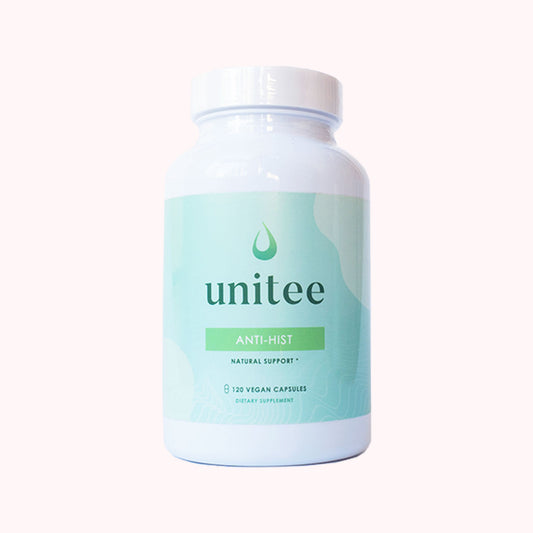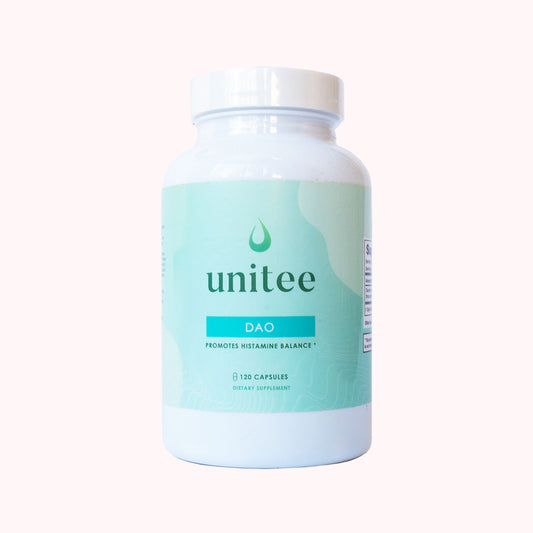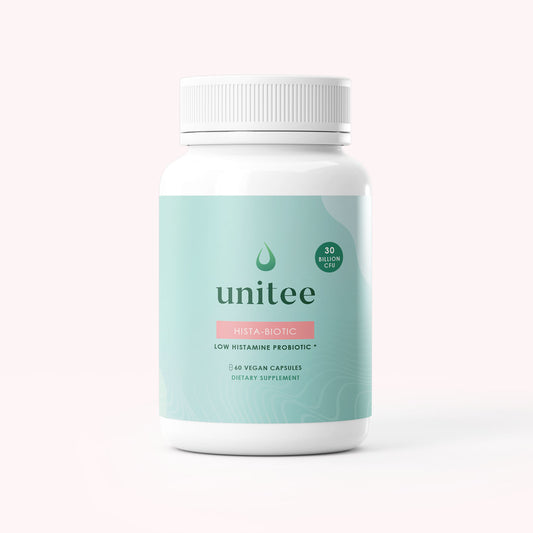Did you know that there is a close relationship between histamine intolerance and stress?
In fact, the levels of stress and histamine release impact one-another dramatically.
And - your brain may be influencing everything from your sleep to your symptoms. Especially if it's severe, as in the case of panic attacks, anxiety and depression.
So, whether it's common daily stress or extreme stress - let's get to discussing the relationship between histamine and stress.
And, how stress and histamine release may be creating a cycle that's doing your body more harm than necessary.
Histamine Intolerance Revealed
Histamine is an essential neurotransmitter with involvement in the digestive, immune and central nervous systems. There are four types of histamine receptors located throughout the body:
1. H1 receptors are present in the cells involved in inflammation and allergic responses.
2. H2 receptors can be found in the stomach, where histamine is involved in the release of gastric acid as part of the digestive process.
3. H3 receptors are primarily found in the brain, where histamine acts as a neurotransmitter.
4. H4 receptors are found in a broad range of the body’s organ tissues and participate in histamines interaction with key granulocytes such as mast cells.
While histamine is an essential component of a healthy body, research suggests that at least 1% of the population suffer with histamine intolerance (1). When histamine is accumulated in excess, it can trigger a myriad of seemingly unrelated and debilitating symptoms.
Unfortunately, most individuals and often even healthcare providers have never heard of histamine intolerance making it highly under recognized.
Many of us are familiar with the term ‘histamine’ as it relates to allergies, however the context for its role in a broader range of disorders is often poorly understood.
As histamine primarily travels via the bloodstream, it can have a vast reaching influence on the gut, brain, skin and heart often resulting in the experience of anxiety, panic attacks and even insomnia.
What Causes Histamine Intolerance?
Histamine intolerance results from histamine excess in the body. When a disproportion between the amount of histamine being released and the body’s ability to metabolize it exists, histamine builds up in the system, often triggering a myriad of uncomfortable symptoms (2).
There are many causes of histamine intolerance - for a more comprehensive explanation, read my post on causes of histamine intolerance. To keep things brief for this post, I've summarized some of the causes below:
Mast cell release and mast cell activation syndrome
As part of the body’s natural immune response, when an allergen is detected, it binds to immunoglobulin-E (IgE) antibodies, which signal the body’s mast cells to release inflammatory substances such as histamine. In this case, a good mast cell stabilizer can act as a "miracle in a bottle" for reducing symptoms and increasing food tolerance.
In mast cell activation syndrome, the mast cells are overly active and mistakenly release an overwhelming amount of histamine. Mast cell activation syndrome is often a case where the mast cell stabilizers mentioned above can help.
Diamine Oxidase (DAO) deficiency
DAO is an enzyme in the gut which regulates the resorption of histamine in the intestine. When DAO is inhibited, histamine cannot be broken down correctly and so levels of histamine in the body increase (1). This enzyme is super important because it specifically targets ingested histamine, meaning the histamine that enters our bodies through food and environmental exposures.
Those who are deficient in this enzyme can use a DAO supplement to help break down incoming histamine and therefore reduce histamine symptoms while typically being able to consume more foods. Used in combination with a mast cell stabilizer, the result is more histamine breakdown and less histamine release.
Gut dysfunction and bacterial imbalance
As histamine is both produced and broken down in the gut, compromised gut health can cause imbalanced histamine levels. For this reason, there is often a similarity between symptoms of bacterial overgrowth, irritable bowel syndrome (5), leaky gut and histamine intolerance. In this case, using a histamine-safe probioticis a good place to start enhancing gut health.
It's also important to note that many "good" bacteria will naturally produce histamine. For this reason, ensuring any probiotics you take do not consume histamine producing bacteria is a must, as well as combining your gut health therapies with other strategies for reducing histamine.
Remember, we can never totally eliminate histamine from our bodies as it is a natural compound. It will be in foods, it will be released by our mast cells and our bacteria will naturally create it. It's all about managing your levels.
Eating histamine-rich foods and beverages
Histamine occurs naturally in the foods and drinks we consume. Those who suffer with histamine intolerance often see their symptoms worsen after the consumption of high histamine items such as cheese, chocolate and alcohol (3). Sticking to a diet that eliminates high histamine foods and histamine releasing foods is essential. If you are looking for a comprehensive diet, click the button below to download the free low histamine diet.
Regardless of the root cause, one thing is for sure: stress is a negative addition that can increase histamine release and significantly worsen symptoms. Let's discuss why that is.
How are Histamine Intolerance and Stress Related?
Stress, in particular, can be a problem for those experiencing histamine intolerance, as it can trigger an increase in histamine release, often exacerbating present symptoms.
Let me give you a brief science lesson...
When the body is under stress, it releases the stress hormone cortisol which calls the nervous system into action. The hypothalamic-pituitary adrenal axis is then stimulated by the nervous system which puts the body into ‘fight or flight’ mode.
This cascade of events signals the body that it is under attack and, so, all of its resources are poured into energy conservation, which causes high energy processes such as digestion to shut down.
Following this, the sympathetic nervous system is engaged; releasing neurotransmitters such as adrenaline, noradrenaline and dopamine to sharpen the senses and put your body on high alert for danger.
As part of this stress response, the sympathetic nervous system can further activate the immune system, leading to mast cell degranulation and the release of even more histamine into the bloodstream.
Histamine and stress are related in this way, with the outcome being that stress increases histamine release.
While these evolutionary mechanisms are advantageous when the body is under significant external threat, the real problem occurs when this stress response is habitually triggered due to the various environmental and psychological stressors we are frequently exposed to.
Over time, the histamine and stress response cycle can increase histamine release, which can spark a number of symptoms, including:
Histamine Intolerance and Anxiety & Depression:
Histamine and stress are able to cause significant mood disorders due to the role of histamine in the brain.
The presence of H3 histamine receptors in the brain explains the high occurrence of mood disorders in those who are histamine intolerant.
In the brain, histamine acts as a neurotransmitter which can affect the levels of mood altering neurotransmitters such as GABA, dopamine and serotonin; causing the increased expression of anxious and depressive feelings.
It's really notable that almost every single histamine intolerance sufferer I have worked with reports some form of mood issues, most typically anxiety.
If you are suffering from these issues, it is important to remember that your biology can play a huge role and resolving biological issues can assist with alleviating psychological issues as well.
Histamine Intolerance and Insomnia:
Histamine has been indicated in the onset of sleep disturbances; both in the case of insomnia and excessive sleepiness. Recent research reveals that histamine may in fact play an integral role in the circadian rhythm (6).
In fact, the histaminergic system is localized within the hypothalamus brain region which can directly influence many aspects of the central nervous system. It has been found that activation of the H1 histamine receptor promotes sleep, while H3 receptor activation stimulates increased wakefulness (7).
Not only can the relationship between histamine and stress throw off sleep balance and promote insomnia in the first place. But, the lack of sleep can cause increased stress and histamine release, therefore cyclically worsening these issues.
Histamine Intolerance and Panic attacks:
Under conditions of excess histamine levels, many individuals report experiencing regular and debilitating panic attacks. These panic attacks can be partially attributed to the role of histamine in vasodilation or the widening of blood vessels within the heart (8).
This function causes blood pressure to drop as blood flows through the vessels more freely. In conjunction, the heart rate increases in order to continue pumping a consistent level of blood through the newly widened vessels.
This reduction in blood pressure combined with the increased heart rate can result in shortness of breath, dizziness and a rapid heartbeat; together causing the individual to feel as though they’re experiencing a panic attack.
Again, the connection between histamine and stress can worsen issues such as panic attacks, with the further issue being that stress and histamine release both increase.
As with the other conditions discussed, this may potentiate further panic attacks, and increase both histamine and stress levels.
7 Ways to Reduce Histamine and Stress
When it comes to histamine and stress, it's important to note that stress acts as the trigger rather than the cause of histamine intolerance. However, taking steps to manage your stress levels can still be very effective in minimizing your symptoms.
Working to identify the source of your stress as well as taking steps to manage it effectively are important practices to adopt.
Although personal sources of stress may vary, below are some universal methods for effectively reducing stress and histamine release.
1. Magnesium Supplementation
Pay attention to your magnesium levels as stress can deplete magnesium in the body, while a lack of magnesium can amplify the stress reaction.
Magnesium is incredibly interesting as it's involved in relaxation, fearlessness and can act as a significant sleep aid. The result of a magnesium deficiency can be just that - anxiousness and fear, feeling on edge and unable to relax, difficulty sleeping and other issues often related to nervous system signalling and functioning.
Magnesium is found in a variety of vegetables, nuts and seeds, however during very stressful times, taking a magnesium supplement is recommended. Keep in mind, magnesium comes in many forms so opting for a full-spectrum magnesium supplement can help to cover all bases in terms of deficiencies and support all bodily processes.
2. Diet
By controlling the amount of histamine coming into your body through the foods you eat, you can significantly reduce the levels of histamine which your body has to deal with. This reduces biological stress and can therefore calm stress-induced histamine release as well.
The best way to do this is by following a low-histamine diet plan while closely monitoring and recording your symptoms. Additionally, eliminating foods that are not high in histamine themselves but either provoke histamine release or can be bacterially converted to histamine in the body is essential as well.
If your current diet is not ticking all of these boxes and effectively reducing your symptoms, click the button below to get my free diet which I've personally designed to reduce both incoming and internal histamine sources.
Once you reach the point where your symptoms have noticeably reduced, you can begin to reintroduce a few moderate to high level histamine foods back into your diet and record your reaction.
The response to different foods tends to vary significantly between individuals so it’s best to follow this process slowly; introducing one new food every 3-4 days.
3. Avoid Known Allergens.
As histamine release is intrinsically linked to the allergic response, it is important to avoid known allergens such as pollen or dander.
If you can’t control your exposure to an allergen, for example in the case of seasonal allergies, then adhering to a very low histamine diet as well as following the other listed suggestions during these times can help you to avoid reaching your body’s histamine threshold.
4. Polyphenols
Polyphenols are a type of phytochemical found abundantly in a variety of fresh fruits and vegetables. Pomegranates contain tannins and anthocyanin, two types of polyphenols which have been shown to stabilize mast cells (10). Apples also contain a variety of polyphenols which can inhibit the release of histamine from mast cells (11).
One of my favorite recipes, which was shared with me by one of my university professors, is a simple yet incredibly clever recipe for stewed apples that is designed to utilize their high polyphenol concentrations in order to improve a variety of body systems and overall health. Try out this simple and delicious stewed apples recipe for histamine intolerance.
5. Diamine Oxidase (DAO) enzymes
If you suspect that your DAO levels are low, consider trying a DAO supplement, alongside these natural methods to increase DAO enzymes. Increasing DAO will support the body in breaking down and managing excess histamine and reduce your biological stress load.
The reason DAO is so important is because it degrades ingested histamine. What this means is that the histamine that enters your system through eating food or through environmental exposures can be broken down more effectively if you have adequate levels of DAO.
By using DAO-boosting foods or, more powerfully, DAO supplements, people typically are able to tolerate more foods without having to stress about it, because their body can handle the histamine load.
6. B6
Vitamin B6 is required for the production of DAO enzymes in the body and so it is important that you are getting enough in your diet. B6 is found in a variety of low-histamine foods such as brown rice, vegetables and fresh poultry. If you’re worried about your levels, you can also take B6 as a supplement.
I recommend getting it in its active form, pyridoxal 5’-phosphate, which will enable the body to absorb and utilise it more easily. Start by taking 50mg/day with food and increase to 100mg/day as needed.
7. Mast Cell Stabilizers
Using an all-natural mast cell stabilizer is one of the safest and most effective ways to reduce internal histamine levels aside from proper diet.
Mast cell stabilizers are able to reduce both biological stress and histamine release internally. This method is great if you're looking to widen your variety of foods that are "safe" for you to consume without a reaction.
With my clients, I personally use the all-natural antihistamine called Anti-Hist, which is made from natural ingredients and has been described by my clients as a "wonder-drug" and "miracle in a bottle" for it's ability to reduce symptoms and increase food choice.
Targeting the root of your histamine intolerance
While the above methods are very useful in controlling both mental and biological stressors that accompany histamine intolerance, it's important to remember that targeting the root cause of your intolerance is essential in solving your symptoms for good.
For more info on how to discover the root cause, check out my free histamine guide which contains a full diet to follow, along with step-by-step instructions on discovering the root cause and how I personally solved my histamine intolerance.
Click the button below to download your free guide.
Get Your FREE histamine diet guide
I'm always here to help with as much information as I can provide you. Please use my free recipes and resources to learn more about histamine intolerance and kick-start you on a low histamine diet with all of the helpful resources to begin your healing journey.
References:
- Maintz L, Novak N. Histamine and histamine intolerance. Am J Clin Nutr [Internet]. 2007 May [cited 2016 Dec 27];85(5):1185–96.
- Hanusková E, Plevková J. [Histamine intolerance]. Ceskoslov Fysiol [Internet]. 2013 [cited 2017 Dec 16];62(1):26–33.
- Amon U, Bangha E, Küster T, Menne A, Vollrath IB, Gibbs BF. Enteral histaminosis: Clinical implications. Inflamm Res [Internet]. 1999 Jun 17 [cited 2017 Nov 25];48(6):291–5.
- Fabisiak A, Włodarczyk J, Fabisiak N, Storr M, Fichna J. Targeting Histamine Receptors in Irritable Bowel Syndrome: A Critical Appraisal. J Neurogastroenterol Motil [Internet]. 2017 Jul 30 [cited 2018 Mar 11];23(3):341–8.
- Thakkar MM. Histamine in the regulation of wakefulness. Sleep Med Rev [Internet]. 2011 Feb [cited 2018 Mar 11];15(1):65–74.
- Nakamura Y, Ishimaru K, Shibata S, Nakao A. Regulation of plasma histamine levels by the mast cell clock and its modulation by stress. Sci Rep [Internet]. 2017 Jan 11 [cited 2018 Mar 11];7:39934.
- Jin H, Koyama T, Hatanaka Y, Akiyama S, Takayama F, Kawasaki H. Histamine-induced vasodilation and vasoconstriction in the mesenteric resistance artery of the rat. Eur J Pharmacol [Internet]. 2006 Jan 4 [cited 2018 Mar 11];529(1–3):136–44.
- Kass L, Rosanoff A, Tanner A, Sullivan K, McAuley W, Plesset M. Effect of transdermal magnesium cream on serum and urinary magnesium levels in humans: A pilot study. PLoS One [Internet]. 2017 [cited 2018 Mar 12];12(4):e0174817.
- Rasheed Z, Akhtar N, Anbazhagan AN, Ramamurthy S, Shukla M, Haqqi TM. Polyphenol-rich pomegranate fruit extract (POMx) suppresses PMACI-induced expression of pro-inflammatory cytokines by inhibiting the activation of MAP Kinases and NF-κB in human KU812 cells. J Inflamm [Internet]. 2009 Jan 8 [cited 2018 Mar 11];6(1):1.
- KANDA T, AKIYAMA H, YANAGIDA A, TANABE M, GODA Y, TOYODA M, et al. Inhibitory Effects of Apple Polyphenol on Induced Histamine Release from RBL-2H3 Cells and Rat Mast Cells. Biosci Biotechnol Biochem [Internet]. 1998 Jan 22 [cited 2018 Mar 11];62(7):1284–9.

Anita Tee
My name is Anita Tee. I'm a nutritional scientist specializing in histamine intolerance. I hold a Master of Science in Personalized Nutrition and a Bachelor of Science in Human Biology and Psychology.
For the past ten years, I have used my experience in nutritional and medical health sciences to create a scientifically backed, natural approach to healthcare that relies 100% on evidence-based research.
As I previously suffered from - and overcame - histamine intolerance, my focus is to increase recognition and expand the available resources and protocols for resolving the disorder. To date, I have helped over 4,000 individuals fully resolve or better manage their histamine intolerance symptoms.







